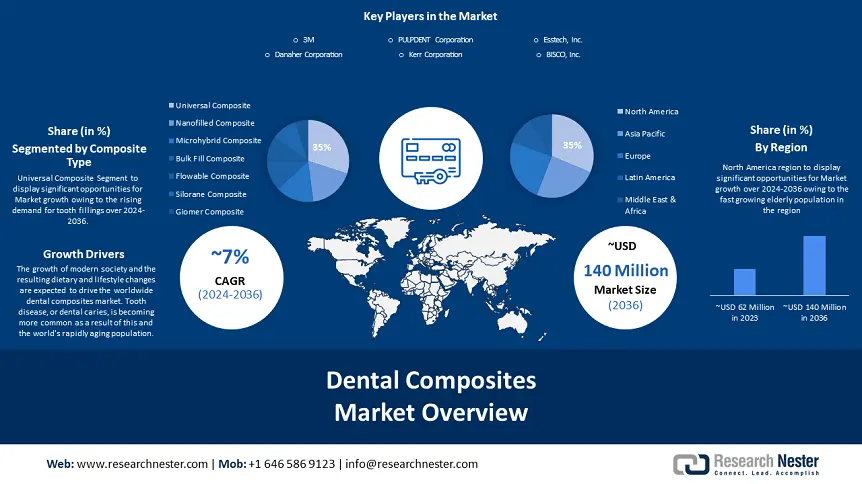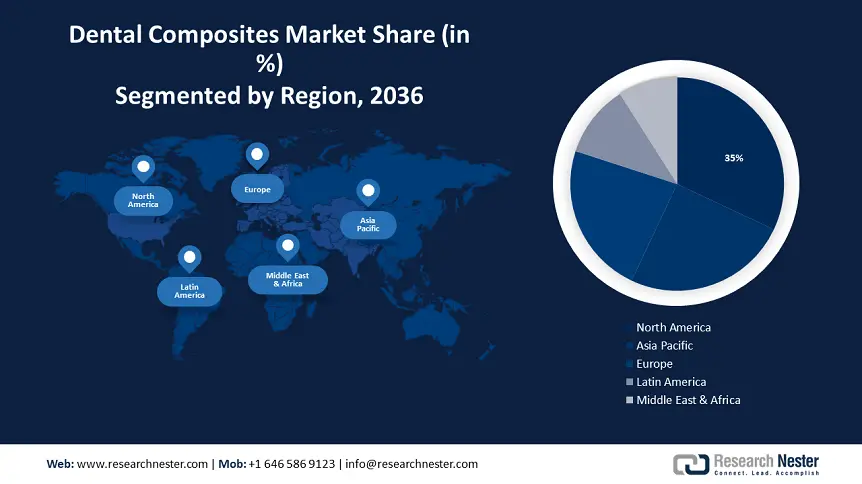
Dental Composites Market size is expected to trace USD 140 Million by the end of 2036, growing at a CAGR of 7% during the forecast period, i.e., 2024-2036. In the year 2023, the industry size of dental composites was USD 62 Million. The growth of modern society and the resulting dietary and lifestyle changes are expected to drive the worldwide market. Tooth disease, or dental caries, is becoming more common as a result of this and the world's rapidly aging population. 771 million individuals worldwide were 65 years of age or older in 2022, making up about 10% of the world's population.
In addition to these, Dental crowning and amalgam are known to be more expensive than dental composites. Furthermore, dental composites conserve the majority of the natural tooth in contrast to dental crowning, which necessitates removing the healthy tooth material to place the crown over it. The dental composites market is expected to be driven throughout the projected period by patients who would prefer to keep their natural teeth.

Growth Drivers
Challenges
|
Base Year |
2023 |
|
Forecast Year |
2024-2036 |
|
CAGR |
~ 7% |
|
Base Year Market Size (2023) |
~ USD 62 Million |
|
Forecast Year Market Size (2036) |
~ USD 140 Million |
|
Regional Scope |
|
Composite Type (Nanofilled Composite, Microhybrid Composite, Bulk Fill Composite, Universal Composite, Flowable Composite, Silorane Composite, Giomer Composite)
Based on composite type, universal composite is expected to hold 30% share of the dental composites market by 2036. Dental fillings are used to treat a variety of dental diseases, including tooth decay and broken teeth. The rising demand for tooth fillings is thought to be the cause of these conditions' increased prevalence. For instance, in patients older than 40, about 80% of them have fractured teeth. Incomplete tooth fractures with intact pulps occur 9.7% of the time. This is attributed to a rise in the quantity of universal composite products made by major manufacturers. Additionally, by using universal composites, dentists can use fewer materials, which can expedite treatments and save time in the dental office.
Application (Dental Fillings, Dental Crowns, Dental Bridges)
Based on application, the dental crowns segment is estimated to hold 40% share of the global dental composites market during the forecast period. The need for cosmetic dentistry, particularly dental crowns, is being driven by a growing emphasis on appearance and aesthetics. Dental crowns can be used to make teeth that are discolored, uneven, or malformed look better, which can increase one's self-esteem and confidence. As per the World Health Organization's (WHO) 2022 Global Oral Health Status Report, oral illnesses afflicted up to 3.5 billion people globally, with three out of four affected individuals living in middle-income nations. Around 2 billion adults worldwide suffer from dental decay in their permanent teeth, while 514 million infants suffer from dental decay in their baby teeth.
Our in-depth analysis of the global dental composites market includes the following segments:
|
Physical State |
|
|
Composite Type |
|
|
Filling Type |
|
|
Application |
|
|
End-User |
|
North American Market Forecast
Dental composites market is attributed to hold the largest revenue share of about 32% during the forecast period. Dental composites are becoming more and more popular in North America for a variety of reasons, including better aesthetics, increased patient demand, insurance coverage, safety concerns, and improved technology.
the region's well-established healthcare system and the rising incidence of oral disorders as contributing reasons. In addition, some of the major factors driving the dental composites market growth are the presence of major industry players in the region and the fast-growing elderly population. For instance, between 2009 and 2019, the number of Americans 60 and older rose by 34%, from 55.7 million to 74.6 million.
APAC Market Statistics
Dental composites market is projected to hold the second largest revenue share of about 25% during the forecast period. China's dental composites industry is primarily driven by a rising middle-class population and rising disposable income. A rise in disposable income is probably going to cause spending on dental care and other aspects of health and well-being to increase. China's National Bureau of Statistics reports that in 2020, the average disposable income per person in urban regions grew by 4.7%. Nearly 90% of people in China suffer from dental caries, which is the most prevalent dental illness in the country, according to the Chinese Stomatological Association.


Author Credits: Radhika Pawar
Copyright © 2024 Research Nester. All Rights Reserved

FREE Sample Copy includes market overview, growth trends, statistical charts & tables, forecast estimates, and much more.
Have questions before ordering this report?